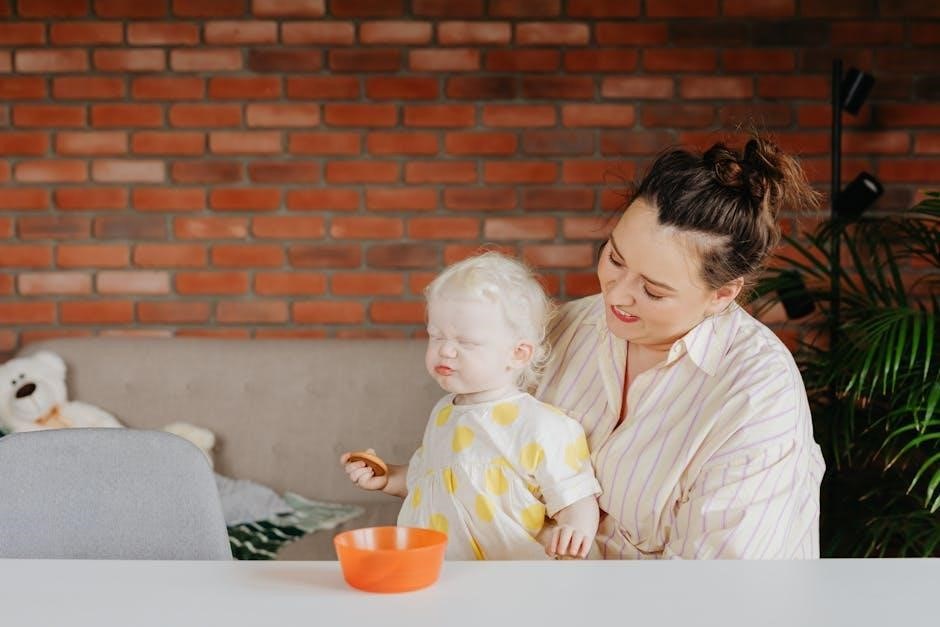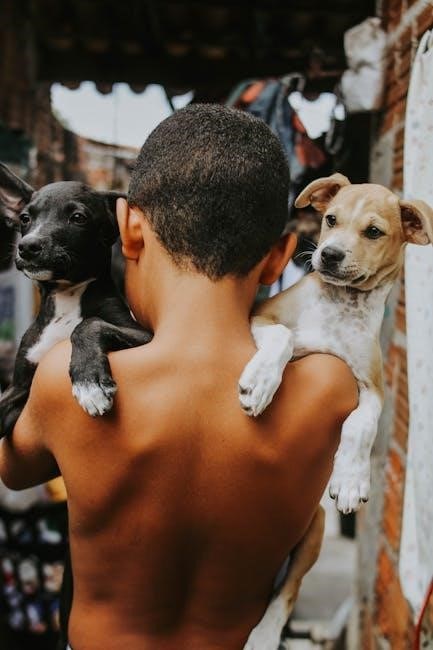Dogs are loyal and loving animals, making them wonderful companions for families. With over 340 breeds, each dog has unique traits, offering endless opportunities for friendship and learning.
1.1 Why Dogs Make Great Pets
Dogs are loyal and loving companions, offering friendship and joy to families. They encourage responsibility, especially for kids, by teaching them to care for another living creature. Their playful nature and ability to listen make them wonderful friends. Dogs also provide comfort and unconditional love, creating a sense of belonging and security. Whether they’re big or small, dogs bring endless happiness and fulfillment to our lives, making them the perfect addition to any family.

1.2 Different Breeds and Their Characteristics
Dogs come in over 340 breeds, each with unique traits. Small breeds like Bulldogs are gentle and calm, while large breeds like Golden Retrievers are energetic and friendly. Some, like Border Collies, are highly intelligent and great at herding, while others, like Greyhounds, are built for speed. Understanding these differences helps families choose a dog that fits their lifestyle. Breeds also vary in grooming needs, energy levels, and temperaments, making it important to match the right dog to the right home.
Understanding Dog Behavior
Dogs behave uniquely based on breed, personality, and environment. Their actions often signal emotions or needs, making it vital to recognize patterns for safe interactions and care.
2.1 How Dogs Communicate
Dogs communicate in various ways, mainly through body language and sounds. They use tail wagging, barking, and growling to express emotions like excitement, fear, or aggression. Eye contact and ear positions also signal their mood. For example, a wagging tail can mean happiness, while flattened ears may indicate stress. Understanding these cues helps build a stronger bond and ensures safe interactions. Always pay attention to context to interpret their signals accurately and respond appropriately.
2.2 Reading a Dog’s Body Language
Dogs communicate mostly through body language. A wagging tail can mean excitement or happiness, while a tucked tail might show fear. Ears up often signal confidence, while laid-back ears can indicate anxiety. If a dog’s fur stands up or they show teeth, it’s a sign they might feel threatened. Always look for these cues to understand how a dog is feeling. If a dog seems tense or avoids eye contact, it’s best to give them space. Learning these signs helps you interact safely and respectfully with dogs.

How to Approach and Interact with Dogs Safely
Always move calmly, avoid sudden gestures, and let dogs sniff your hand before petting. Never disturb a dog while eating or sleeping to ensure safe interactions.

3.1 The Proper Way to Greet a Dog
To greet a dog safely, approach calmly and avoid direct stares. Let the dog sniff your hand before petting, starting with light touches. Never rush or make sudden moves. If a dog shows signs of fear or aggression, slowly back away. Always ask the owner’s permission first. Supervision by an adult is essential to ensure a positive interaction for both the child and the dog. Respectful greeting habits help build trust and prevent unintended reactions.
3.2 Safe Play with Dogs
Always supervise playtime with dogs, especially for young children. Teach kids to handle dogs gently, avoiding pulling ears or tails. Use appropriate toys and avoid small parts that could be swallowed. Monitor the dog’s body language; if it shows signs of stress, like raised hackles or growling, stop play immediately. Encourage calm behavior and avoid roughhousing. If a dog becomes overly excited, give it space to calm down. Reward the dog for staying calm, reinforcing positive behavior. Remember, safe play ensures fun for both kids and dogs while building trust and respect.

Caring for a Dog
Caring for a dog involves providing daily needs like food, water, exercise, and shelter. Regular grooming and hygiene practices ensure your dog stays healthy and happy.
4.1 Daily Needs: Feeding, Exercise, and Shelter
Dogs need consistent care to stay healthy and happy. Feeding them high-quality food twice a day, with portion sizes based on their age and breed, is essential. Exercise varies by breed—some need lots of activity, while others are content with shorter walks. Shelter means a safe, cozy space where they can rest and feel protected. Providing fresh water, a warm bed, and a secure area ensures their basic needs are met. These daily habits show your dog love and responsibility, helping them thrive as part of your family.
4.2 Grooming and Hygiene
Grooming is essential for your dog’s health and happiness. Brush their fur regularly to prevent tangles and mats, and trim their nails to avoid overgrowth. Clean their ears and eyes to keep them free from dirt. Bathing should be done as needed, depending on the breed and lifestyle. Teach your kids to handle grooming gently, making it a fun bonding time. Proper hygiene also includes regular dental care and checking for dirt or tangles in their coat. A well-groomed dog is a healthy and happy companion!

Safety Tips for Kids Around Dogs
Kids should move calmly and gently around dogs, never tease or startle them. Teach children to respect a dog’s space and avoid disturbing them while eating or sleeping.
5.1 Preventing Dog Bites
Preventing dog bites starts with understanding dog behavior. Avoid provoking dogs, especially when they’re eating, sleeping, or with puppies. Teach kids to let dogs approach first and read body language—stiffness or raised hackles can signal stress. Never leave young children alone with dogs, and ensure pets are well-socialized. Tethering dogs outdoors can increase bite risks, as they may feel trapped. Educate kids to move calmly and avoid sudden gestures. Responsible ownership and awareness are key to fostering safe interactions between children and dogs.
5.2 What to Do in Case of a Dog Emergency
In a dog emergency, stay calm and act quickly. If a dog is injured, check for visible wounds and apply gentle pressure to stop bleeding. Secure the dog in a safe space to prevent further harm. Contact a trusted adult or veterinarian immediately. For bites or scratches, wash the area with soap and water. Never punish the dog, as this can worsen the situation. Always prioritize safety and seek professional help to ensure the best outcome for both the dog and everyone involved.

Choosing the Right Breed for Your Family
Choosing the right breed involves considering your family’s lifestyle, living space, and energy levels to ensure a great match. Involve kids in the decision to teach responsibility.
6.1 Factors to Consider When Selecting a Breed
When choosing a dog breed, consider factors like energy levels, size, and grooming needs. Some breeds require lots of exercise, while others are more laid-back. Think about your family’s lifestyle and living situation—apartment dwellers might prefer smaller breeds, while active families might enjoy larger, energetic dogs. Allergies and budget are also important. Research breeds thoroughly to ensure they align with your family’s needs and dynamics, especially if kids are involved. Spending time with a breed before committing can help make the right choice.
6.2 Involving Kids in the Process
Involving kids in choosing the right dog breed fosters responsibility and excitement. Let them research breeds, focusing on energy levels and temperaments that match your family. Encourage them to ask questions and understand the needs of different dogs. This helps them feel invested in the decision and prepares them for the commitment ahead. It’s a great way to teach kids about teamwork and empathy while finding the perfect furry friend for your home.

Fun Activities to Do with Your Dog
Outdoor games like fetch, hide-and-seek, and hiking are great ways to bond with your dog. These activities provide exercise and create lasting memories together.

Teaching your dog tricks, using interactive toys, and engaging in obedience training are fun ways to keep your dog stimulated and strengthen your friendship with them.
7.1 Outdoor Games and Adventures
Outdoor adventures with your dog are a blast! Try hiking, fetch, or hide-and-seek to keep your dog active and happy. Always use a leash in public spaces and carry water to keep your dog hydrated. These activities strengthen your bond and provide exercise. With patience and practice, outdoor adventures can be safe and fun for everyone!
7.2 Teaching Your Dog Tricks
Teaching your dog tricks is a fun way to bond and challenge their mind. Start with simple commands like “sit” or “shake,” using treats as rewards. Be patient and consistent. Trick training strengthens your relationship and keeps your dog active. Try advanced tricks like “roll over” or “play dead” once basics are mastered. Use positive reinforcement and celebrate small successes. This activity not only entertains but also helps your dog feel accomplished and loved. Make it a fun, shared experience for the whole family to enjoy together!

Dogs bring immense joy and responsibility into our lives. This guide has shown how kids can build strong, loving relationships with their furry friends. Happy adventures await!
8.1 The Joy of Having a Dog as a Pet
Owning a dog brings immense happiness and companionship. Dogs offer unconditional love, loyalty, and excitement, making every day an adventure. Whether it’s playful moments, cuddles, or teaching tricks, dogs enrich lives with joy. They encourage outdoor activities, friendship, and responsibility, creating lifelong memories. The bond between a child and their dog fosters empathy, trust, and understanding, making the experience truly special and fulfilling for the whole family.
8.2 Final Tips for Kids
Always treat dogs with kindness and respect. Move calmly, avoid sudden gestures, and never tease. Let dogs sniff your hand before petting, and ask the owner’s permission first. If a dog seems scared or aggressive, stay still and back away slowly. Never disturb a dog while it’s eating or sleeping. Keep small toys and food out of reach to avoid accidents. Lastly, always listen to grown-ups when they give instructions about interacting with dogs.
